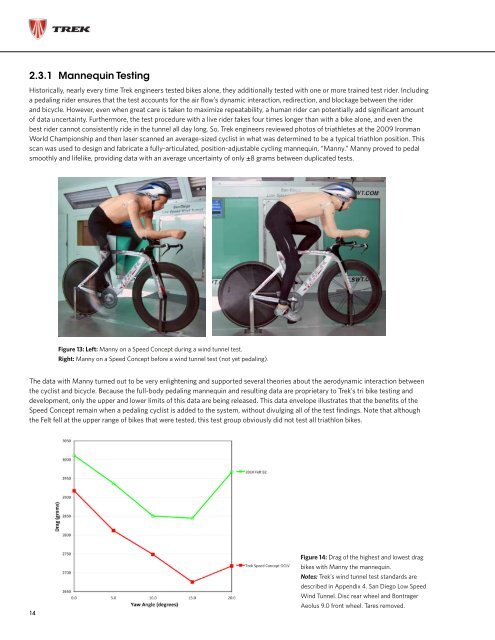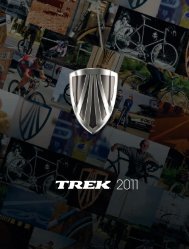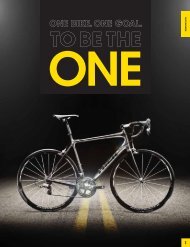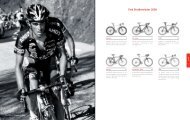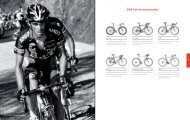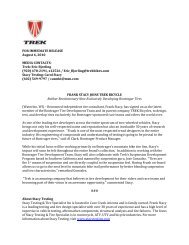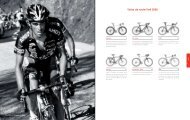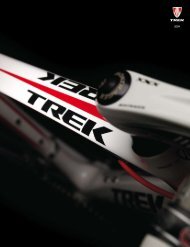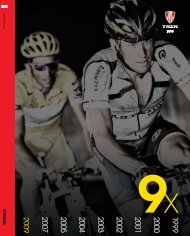Airfoil Development for the Trek Speed Concept ... - Slowtwitch.com
Airfoil Development for the Trek Speed Concept ... - Slowtwitch.com
Airfoil Development for the Trek Speed Concept ... - Slowtwitch.com
You also want an ePaper? Increase the reach of your titles
YUMPU automatically turns print PDFs into web optimized ePapers that Google loves.
2.3.1 Mannequin Testing<br />
Historically, nearly every time <strong>Trek</strong> engineers tested bikes alone, <strong>the</strong>y additionally tested with one or more trained test rider. Including<br />
a pedaling rider ensures that <strong>the</strong> test accounts <strong>for</strong> <strong>the</strong> air flow’s dynamic interaction, redirection, and blockage between <strong>the</strong> rider<br />
and bicycle. However, even when great care is taken to maximize repeatability, a human rider can potentially add significant amount<br />
of data uncertainty. Fur<strong>the</strong>rmore, <strong>the</strong> test procedure with a live rider takes four times longer than with a bike alone, and even <strong>the</strong><br />
best rider cannot consistently ride in <strong>the</strong> tunnel all day long. So, <strong>Trek</strong> engineers reviewed photos of triathletes at <strong>the</strong> 2009 Ironman<br />
World Championship and <strong>the</strong>n laser scanned an average-sized cyclist in what was determined to be a typical triathlon position. This<br />
scan was used to design and fabricate a fully-articulated, position-adjustable cycling mannequin, “Manny.” Manny proved to pedal<br />
smoothly and lifelike, providing data with an average uncertainty of only ±8 grams between duplicated tests.<br />
Figure 13: Left: Manny on a <strong>Speed</strong> <strong>Concept</strong> during a wind tunnel test.<br />
Right: Manny on a <strong>Speed</strong> <strong>Concept</strong> be<strong>for</strong>e a wind tunnel test (not yet pedaling).<br />
!<br />
The data with Manny turned out to be very enlightening and supported several <strong>the</strong>ories about <strong>the</strong> aerodynamic interaction between<br />
<strong>the</strong> cyclist and bicycle. Because <strong>the</strong> full-body pedaling mannequin and resulting data are proprietary to <strong>Trek</strong>’s tri bike testing and<br />
development, only <strong>the</strong> upper and lower limits of this data are being released. This data envelope illustrates that <strong>the</strong> benefits of <strong>the</strong><br />
<strong>Speed</strong> <strong>Concept</strong> remain when a pedaling cyclist is added to <strong>the</strong> system, without divulging all of <strong>the</strong> test findings. Note that although<br />
<strong>the</strong> Felt fell at <strong>the</strong> upper range of bikes that were tested, this test group obviously did not test all triathlon bikes.<br />
14<br />
Figure 14: Drag of <strong>the</strong> highest and lowest drag<br />
bikes with Manny <strong>the</strong> mannequin.<br />
Notes: <strong>Trek</strong>’s wind tunnel test standards are<br />
described in Appendix 4. San Diego Low <strong>Speed</strong><br />
Wind Tunnel. Disc rear wheel and Bontrager<br />
Aeolus 9.0 front wheel. Tares removed.


